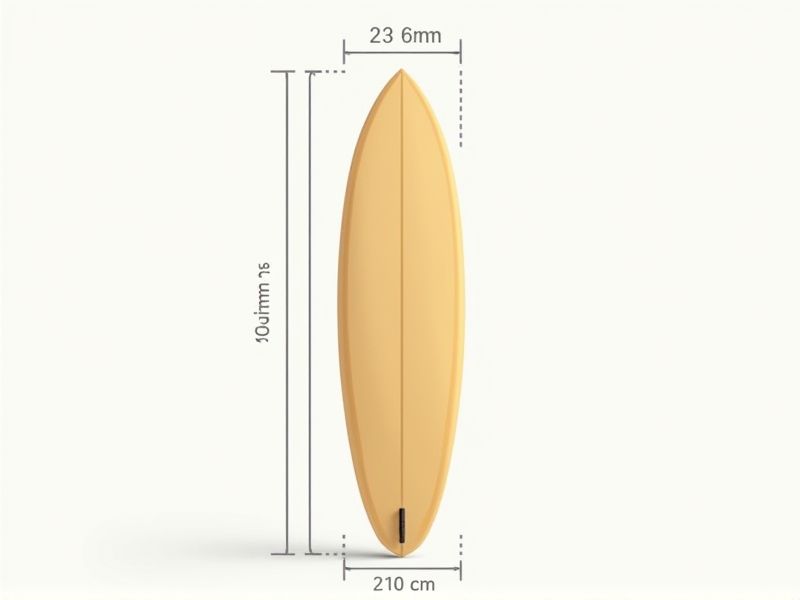
When choosing a surfboard, understanding standard dimensions can help ensure you select the right fit for your skill level and wave conditions. Typically, the length of surfboards ranges from about 5'6" for shortboards up to 9'0" or more for longboards, while the width generally falls between 18" and 23". Thickness is another key factor, usually varying from 2" to 3", which influences the board's buoyancy and performance. Knowing these dimensions makes it easier to find a board that offers the right balance of stability, maneuverability, and float for your surfing goals.
Length
The standard length of surfboards typically ranges from 5 to 10 feet, with shortboards averaging around 6 to 7 feet and longboards spanning 9 to 12 feet. Depending on your skill level, shorter boards offer increased maneuverability, making them ideal for experienced surfers, while longer boards provide better stability for beginners. A surfboard's length significantly impacts its performance in various wave conditions; for instance, longer boards excel in small, mellow waves, allowing for smooth gliding. When selecting a surfboard, consider your height and weight, as these factors can influence the appropriate length for optimal performance.
Width
The width of a surfboard significantly affects its performance in the water, impacting stability, paddling efficiency, and maneuverability. A standard shortboard typically ranges from 17.5 to 21 inches in width, while longboards can measure between 20 and 23 inches. Boards with greater width provide increased floatation, making them suitable for beginners or surfers riding smaller waves. Adjusting the width to match your skill level and wave conditions can enhance your surfing experience.
Thickness
The thickness of a surfboard typically ranges from 2 to 4 inches, significantly impacting buoyancy and stability. Thicker boards, around 3 to 4 inches, provide increased floatation, making them ideal for beginners or larger surfers. On the other hand, thinner boards, approximately 2 to 3 inches, offer better maneuverability and performance for advanced riders. Choosing the right thickness tailored to your skill level and surfing style can enhance your overall experience on the water.
Volume
The volume of a surfboard, often measured in liters, significantly influences performance and buoyancy, making it a critical factor for surfers of all skill levels. A higher volume surfboard, typically ranging from 30 to 50 liters, offers increased paddle power and stability, ideal for beginners or those in larger waves. Conversely, advanced surfers often prefer lower volume boards, between 20 to 30 liters, for enhanced maneuverability and responsiveness. Selecting the right volume based on your weight, skill level, and wave conditions can greatly enhance your surfing experience.
Nose Width
Nose width is a critical dimension in surfboard design, influencing stability and maneuverability during rides. Typically, a wider nose, ranging from 12 to 20 inches, enhances paddling efficiency and provides better buoyancy, especially in smaller waves. In contrast, a narrower nose, usually between 10 to 14 inches, facilitates sharper turns and quicker response on the wave face. When selecting your surfboard, consider how nose width aligns with your surfing style and the wave conditions you typically encounter.
Tail Width
When selecting a surfboard, tail width plays a crucial role in performance characteristics, influencing both maneuverability and stability. A narrower tail, typically 14 to 16 inches, enhances speed and responsiveness, making it ideal for advanced surfers seeking precision in tight turns. Conversely, a wider tail, often ranging from 16 to 20 inches, provides increased flotation and stability, beneficial for beginners and those riding larger waves. Understanding the impact of tail width on your surfing experience can guide you towards the right board for your skill level and surfing style.
Rocker
The rocker of a surfboard, measured in degrees, significantly influences its performance on the water by affecting maneuverability and speed. A board with a pronounced rocker, typically between 2 to 4 inches at the nose, allows for quick turns and responsiveness in choppy conditions, making it ideal for aggressive styles of surfing. Conversely, a flatter rocker, often less than 2 inches, enhances speed and stability, benefiting surfers in smaller, gentle waves. When selecting your surfboard, consider how these rocker profiles align with your skill level and wave conditions to optimize your riding experience.
Rails
Surfboards designed for rail performance typically emphasize the importance of a slender, tapered rail shape that enhances maneuverability and control. Industry standards suggest that optimal rail thickness should range from 1 to 2 inches depending on the board's intended use--shortboards generally favor thinner rails for quick turns, while longboards benefit from fuller, more buoyant rails. Materials like polyurethane and epoxy are commonly used, with epoxy boards weighing approximately 10-15% less than their polyurethane counterparts, resulting in improved responsiveness. For advanced riders, incorporating strategic concaves and rocker profiles can further enhance grip and increase speed on varied wave conditions.
Fin Setup
The fin setup of your surfboard significantly influences its performance, stability, and maneuverability. Generally, surfboards feature a thruster (three fins), quad (four fins), or single fin arrangement, each providing unique handling characteristics; for instance, the thruster offers a balanced ride, while a quad setup promotes speed and drive. The material of the fins, often fiberglass or plastic, also affects flexibility and responsiveness in the water. Adjusting the fin placements can further fine-tune your board's performance, allowing you to customize it for specific wave conditions or personal preferences.
Bottom Contour
The bottom contour of a surfboard significantly influences its performance, with key shapes such as single concave, double concave, and V-bottom each offering distinct handling characteristics. For instance, a single concave provides smooth flow and increased speed, while a double concave enhances maneuverability and control, particularly in critical waves. Understanding your intended surfing style and conditions can help you select a contour that maximizes your experience in the water. Moreover, manufacturers often fine-tune these shapes to cater to specific skill levels, ensuring that the right design can elevate both beginners and seasoned surf enthusiasts alike.
